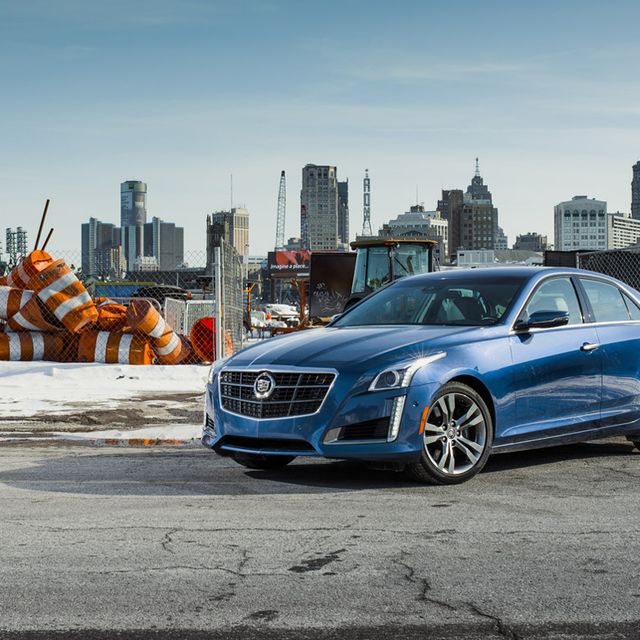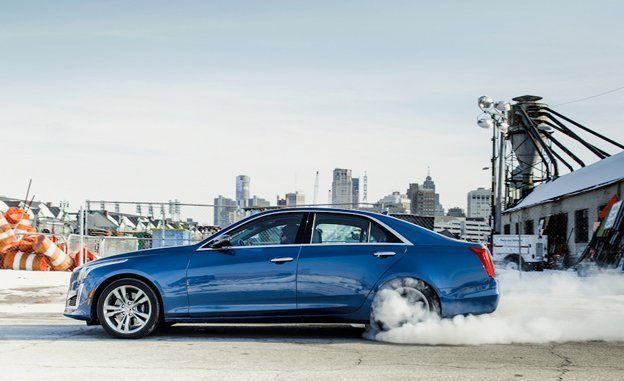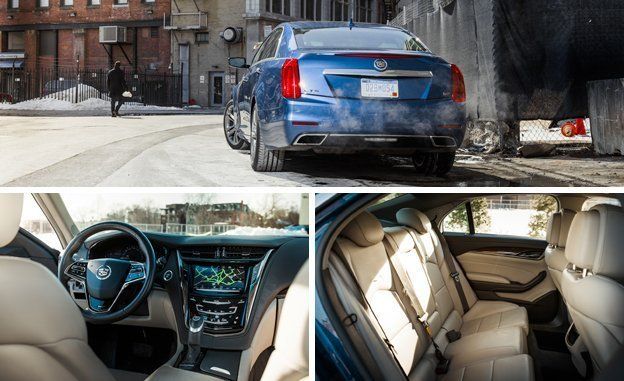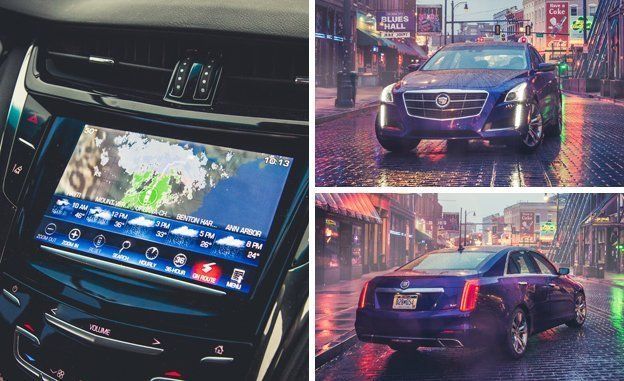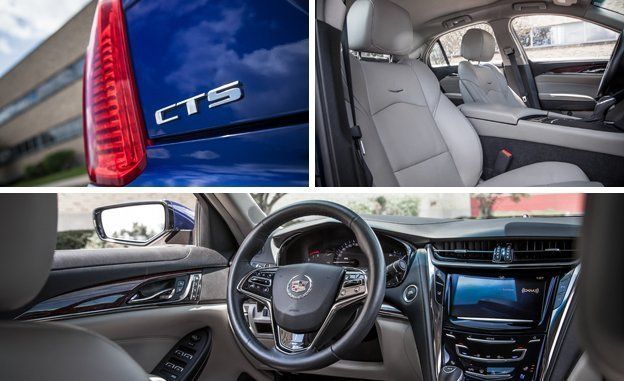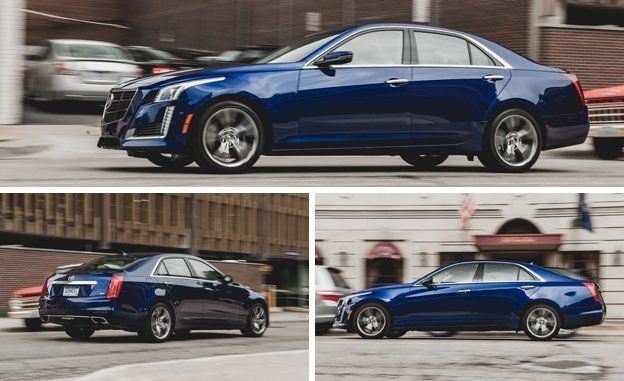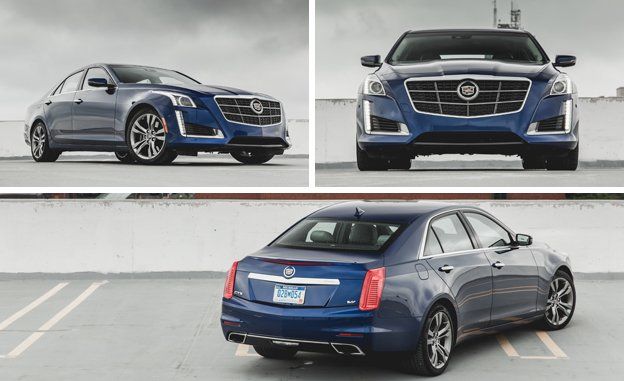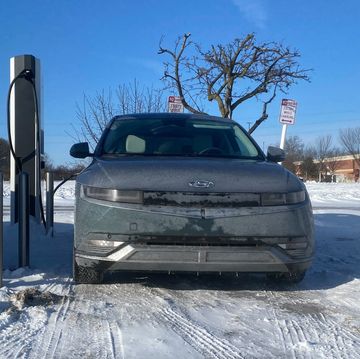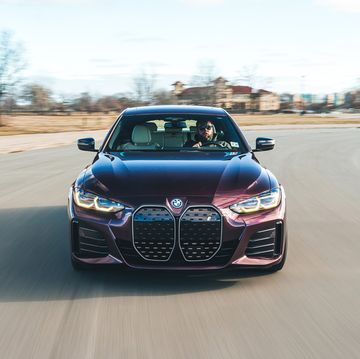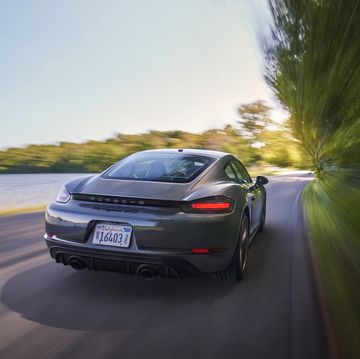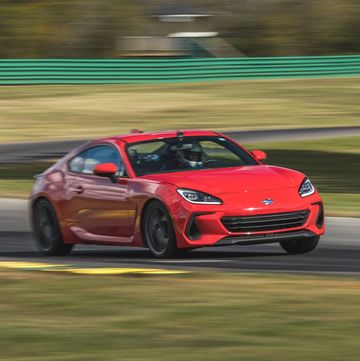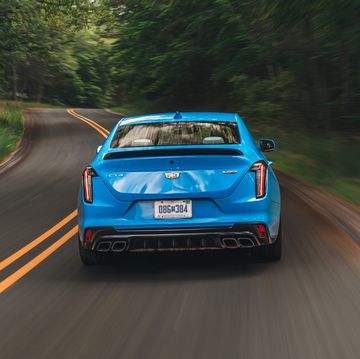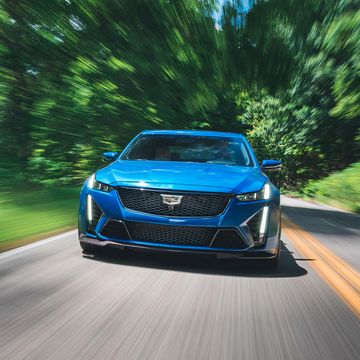In 2014, Cadillac poached, from Infiniti, one of the auto industry’s most celebrated and outspoken execs. It also showed the 464-hp ATS-V and the 640-hp CTS-V, and said that it will be renaming its lineup using designations beginning with either CT (cars) or XT (trucks) followed by a number. But nothing it did generated more hand-wringing than the brand’s announcement that it was moving its headquarters from Detroit to New York City.
Chief among the justifications for the move was to physically separate Cadillac from the rest of General Motors, the better to foster a distinct product portfolio. But that process is already underway. Cadillac’s ATS and the new CTS boast a segment-defining excellence absent in many GM products. Introduced for the 2014 model year, the third-generation CTS—particularly in 420-hp, twin-turbo 3.6-liter V-6–bearing Vsport trim—is a sports sedan of singular focus. Ultra-high-definition feedback streams through the steering, the chassis reacts like that of a 14/10-scale BMW E30, and the engine hurtles the car forward with smoothness and sonorousness heretofore reserved for sixes of the straight Bavarian variety, not bent American ones. We named the CTS to our 10Best list for 2014 and 2015, ordering up a long-termer in between the handoff of the two trophies.
For its 40,000-mile stay, we naturally opted for the $59,995 Vsport, but stopped there, without adding any options. The car comes standard with important mechanical bits such as adaptive magnetorheological shocks, an electronically controlled limited-slip differential, and Brembo brakes. A third zone for the dual-zone climate control or 20-way adjustable seats just seemed like unnecessary embellishments.
And the Vsport impressed right out of the box, sticking to the skidpad at 0.95 g and stopping from 70 mph in just 155 feet—bona fide supersedan numbers. The last BMW M5 we tested couldn’t match either of those figures, and while the lighter M3 manages higher cornering grip, it beats the Vsport’s stopping distance by only two feet. And with two Mitsubishi turbos squeezing 15 psi into the intake, the overachieving 3.6 pushed the CTS to 60 mph in 4.6 seconds, through the quarter-mile in 13.1 at 110 mph, and up to a 171-mph terminal velocity.
We’ll admit to some skepticism and maybe even a little bit of eye rolling when we first heard the output figures for the CTS’s twin-turbo V-6: 420 horsepower at 5750 rpm and 430 pound-feet at 3500. General Motors is not a house renowned for its mastery of turbocharging, and it has a long history of V-6s ranging from humdrum on their best days to dreadful on their worst. But this engine is something entirely different. The torque comes on low and stays so strong throughout the rev range that the 6500-rpm-redline upshifts feel premature. And the sound, enhanced as it is in the style of the day through the audio system’s speakers, is pure sports-car warble. In the same breath—okay, the same press release—as it announced its move to the isle of Manhattan, GM also announced that Cadillac would be reorganized as a separate business unit. That means more autonomy and greater separation from the goings-on in the silvery monolith. And it means more brand-specific engines like this one. New president Johan de Nysschen has already spilled the beans on the twin-turbo V-8 in Cadillac’s future.
Not that the six couldn’t use more massaging. The CTS overlapped our long-term 2013 Audi S7 early in its billet, and the similarities between the two vehicles were hard to ignore. Not just that both were blue luxury cars, but that both had turbocharged engines making 420 horsepower, though the Audi had two more cylinders and an extra 429 cubic centimeters of displacement. It showed in the way the two engines make their power. Under wide-open throttle, both are eye-opening. But in only moderately aggressive driving, Audi’s 4.0-liter V-8 is rheostat smooth, making it easy to dial up precisely the output you demand. The Cadillac, on the other hand, tends to answer middling throttle prods with a slightly embarrassing American boisterousness. Give it half-throttle, and the engine responds as though you’ve floored it. The transmission, too, tugs on the reins, effecting seamless handoffs from ratio to ratio under full throttle but not chilling out quite enough under partial juicing. With all but the lightest throttle applications, shifts are surprisingly harsh. We also noted a disconcertingly rough idle, particularly when the engine was cold, though the ECU was never so bothered by it to throw any trouble codes.
And yet, we did find ourselves at the dealership early on. Just 8700 miles into the CTS’s stay, a front-end rattle sent us to the service desk. Technicians found prematurely worn anti-roll-bar end links, which they replaced under warranty. Cadillac’s Premium Care Maintenance program covered our five oil changes and inspections, but it doesn’t cover things such as wiper blades ($48) or a wheel alignment ($90).
Tires were a bigger problem. We replaced the fronts after rolling 15,216 miles and the rears shortly thereafter, for a total cost of $1407, but someone else’s tire cost us even more. At 27,560 miles, the Vsport got slapped in the face by a chunk of estranged truck tread, prompting $5971 in repairs and a lecture from Alterman on appropriate following distances. Included in the bill: a new hood ($895), bumper cover ($595), headlight assembly ($1250), and driving light ($238). Then, at 37,070 miles, replacing a cracked windshield appropriated another $673 from our Save the Manuals! super-PAC fund.
We would pay for CUE, Cadillac’s deservedly maligned infotainment system, with our patience. Rarely has anything inspired such universal loathing among our staff. Prior experience told us that we would be searching to find nice things to say about it, but we didn’t realize what a futile effort that would be. If you start with contempt, what does familiarity breed? In our case, it was lots of red-faced moments at the wheel and solitary screaming. We may have appeared to other motorists to be anger-management candidates, furiously mouthing obscenities, but that’s only because in the presence of CUE, well, we were. Its slow reaction time, confounding menu structure, and distracting touch-screen interface were only the beginning.
We posit that CUE was conceived on a preliminary expedition to New York—it’s so cosmopolitan, it can’t be bothered with middle America. On two separate Midwestern excursions, it lost track of where it was, once believing the highway we were on to be nonexistent, showing the car in the middle of a field for a good half-hour. And in Michigan’s upper peninsula, it routinely overestimated travel times by absurd intervals, sometimes by a factor of two. It was also unaware of many roads, or was aware of them but didn’t realize they were one-way. That last one is a potentially catastrophic oversight, unacceptable now that we’re a good decade beyond that type of mistake being commonplace. Sure, CUE makes for a sleek dash design, but form over function on this scale should be a cardinal sin—well, unless you’re Apple. Pointing out how the “back” button moves around the screen depending on which menu is displayed, features editor Jeff Sabatini noted, “This is Interface Design 101 stuff, and GM has completely failed.”
And yet, we can forgive the inordinate annoyance triggered by these features in the grand scheme of things. Cadillac has spent the last 13 years making steady and marked improvements to the CTS, and we have rewarded the car with a spot on our 10Best list seven of those years. This latest version is so good at its core, delivering outsized and increasingly rare doses of driver engagement and satisfaction, that we found ourselves liking the car more and more as the miles piled on. Oddly, fewer and fewer buyers seem to realize how good the CTS is. In 2014, this best-ever CTS hit an all-time low—just 31,115 sales.
Here’s the thing about that New York move: It won’t be all of Cadillac. Executives and marketing people are going to the Big Apple to immerse themselves, as GM says, “in a premium lifestyle.” But engineering and product development will remain in the Detroit area. So the people who have been responsible for making the CTS great will keep at it, while the ones responsible for telling people how great it is are heading east.
Detroit has always been a city of doers, New York a city of gabbers. Maybe this arrangement will work out after all.
Rants and Raves
Jeff Sabatini: Just once, I’d like to get in a GM car and say, “Wow, this is a lot nicer than it had to be.” But that may never happen.
Mike Sutton: Forget CUE and give me a damn knob.
Jennifer Harrington: The maps need to be updated. While on U.S. 24 in Ohio, CUE thought I was off-roading for 30 minutes and the road was nowhere in sight on the map.
Ron Sessions: The structural adhesives that GM uses at weld joints to glue each CTS together really pay off in stiffness; this is a very tight structure.
Carolyn Pavia-Rauchman: I’d vote for 100,000 miles in this sedan.
Tony Quiroga: Why doesn’t auto start turn on the heated seats and steering wheel? An annoying nit in an otherwise splendid sedan.
Juli Burke: Enjoy the quick, powerful engine. Despise CUE. Case closed.
Dave Beard: Collision alert had a few miscues. Roadkill set it off once.
Eric Tingwall: If you thought CUE was bad, try using it while wearing gloves.
K.C. Colwell: My 75-year-old father-in-law loved it. “You got a turbo in that?”
Alex Stoklosa: I love the engine note, which has the perfect combination of growl and volume.
Daniel Pund: Insanely small side mirrors on this compared with the elephant ears on European cars.
WHAT WE LIKE: Our CTS has been picking up steam, piling on the miles and charging hard into the home stretch. We’ve been getting it out on the open road a lot lately, where we’ve been relishing its long-haul comfort, easy 400-mile range, and the 3.6-liter’s frugality. On a couple of legs to and from Ithaca, New York, we logged as high as 27 mpg. And, as it nears the 40,000-mile finish line, the CTS still feels remarkably tight, with no squeaks or rattles. Cadillac’s Premium Care Maintenance program means that our last two services have come at no charge.
WHAT WE DON’T LIKE: We’ll skip the easy pickin’s—okay, no we won’t. We’re just holding onto our CUE complaints for another minute or so. Anyway, while we applaud GM for extracting 420 strong horsepower from 3.6 liters, the engine has a hard time producing moderate amounts of that power, taking more of an all-or-nothing approach. Try to drive the Vsport just moderately fast, and you end up getting a lot more power than intended. And in the cold, it idles rough enough that we’re surprised it hasn’t thrown a code.
WHAT WENT WRONG: As previously detailed, we were doing about 70 mph on the highway one day last fall when a chunk of truck tire jumped up and yelled, “Slappa da face, mon!” A new bumper, hood, and left-side headlight assembly later, we were $5971 poorer and more vigilant about our following distances. Just 10,000 miles later, we had to write another check for $673 to replace the windshield, which had been slowly developing a crack directly in the driver’s line of sight.
WHERE WE WENT: The CTS has finally been pulling the sort of long-range duty at which it excels. Since our last update, it’s been to Atlanta, Georgia; Ithaca, New York; and to Michigan’s Upper Peninsula. On the UP’s two-lanes, we had plenty of opportunities to wow ourselves and other drivers with the twin-turbo six’s eye-opening passing power. In our initial testing, the car needed just 2.5 seconds to get from 30 to 50 mph and just 3.3 to go from 50 to 70. In this car, if we weren’t complaining about CUE, we’d hardly complain about anything at all.
Months in Fleet: 13 months
Current Mileage: 38,333 miles Average Fuel Economy: 21 mpg
Fuel Tank Size: 19 gal Fuel Range: 400 miles
Service: $0 Normal Wear: $1457 Repair: $90
Damage and Destruction: $6784
WHAT WE LIKE AND WHY: We still get a little tingly when we look at our long-term Opulent Blue Cadillac CTS Vsport test car, and the tingle sinks in deeper when we think about the power under that sultry hood. With its twin turbos, this car makes as much power as another high-profile four-door in our long-term fleet, the Audi S7. But the Caddy uses just 3.6 liters and six cylinders to make its 420 horsepower; the Audi, a 4.0-liter V-8. In our initial testing, the CTS hit 60 mph in 4.6 seconds and posted 0.95 g on the skidpad. The twin-turbo’s brutal, addictive shove means that we tend to arrive at the end of long freeway-entrance ramps well beyond merge-ready speeds and don’t often use much less than full throttle when accelerating away from stops. We’re smitten with the look of the car’s nose at night, with those vertical LED stacks aglow in an image straight off the Mulsanne straight. Giggity.
WHAT WE DON’T LIKE AND WHY: When we introduced our CTS, we mentioned a couple of warnings that had popped up in the instrument panel, only to disappear without a trace. The car’s electronics suite continues to experience little tics. On a weekend jaunt to Chicago, one editor noted “about a dozen” pop-up alerts of nearby air-quality and flood warnings in the IP over the course of about a minute. Each time he dismissed one, another would immediately take its place. It wasn’t raining, nor had it been, and hadn’t been particularly warm outside. When asked if it was an ozone action day, though, he couldn’t say.
WHAT WENT WRONG AND WHY: The Pirelli P Zero run-flats have been widely criticized for being loud even on smooth pavement. When we took the CTS in for a regularly scheduled checkup at 23,295 miles—free under Cadillac’s Premium Care Maintenance program—the dealer performed an alignment, which is not covered under the program and cost $90. The front tires were so badly feathered, though, that we had to replace them at a cost of $636. A fresh set of wiper blades cost us another $50. In addition, our CTS has fallen under two of GM’s recent 865 or so recalls, one for a wiper module that might go on strike and one to tighten the shift cable.
WHERE WE WENT AND WHY: Since we last checked in, the farthest the CTS has strayed has been down to Richmond, Virginia, where, over a hot, humid weekend, our copy editor soothed her family with the CTS’s cooled front seats and wowed them with its $59,995 price tag. Lucky for her, she knew where she was going, because the CUE system didn’t for an hour or so in the middle of Indiana.
But it’s not all bad for Cadillac’s infotainment whipping boy, as—breaking news!—one staffer wrote in the logbook, “I’m getting more comfortable with CUE.” That means that he’d figured out how to disable its proximity function so that all of the “buttons” display on the screen all the time. He also liked that CUE allows occupants to pair Bluetooth devices while the car is in motion, provided that you press the key indicating that a passenger, and not the driver, is doing the pairing. And the CTS is smart enough to disregard a button push when there’s not someone—or at least a sack of potatoes—buckled into the passenger seat. While it’s possible we’ll find more nice things to say about CUE in the next 16,000 miles, there’s little doubt we’ll keep fawning over the rest of our CTS.
Months in Fleet: 7 months
Current Mileage: 23,752 miles Average Fuel Economy: 20 mpg
Fuel Tank Size: 19.0 gallons Fuel Range: 380 miles
Service: $0 Normal Wear: $686 Repair: $90
Damage and Destruction: $140
The CTS is not only Cadillac’s finest offering, it’s also one of the best cars in all of GM’s lineup: The third-gen car, new for 2014, is one of two General Motors products on our 2014 10Best list. It’s the nameplate’s seventh appearance, which puts this relatively young model in rare company. And we’ve heaped it with rare praise, calling the 2014 model “unequivocally the best-handling car in the mid-size luxury segment.”
But there’s more to mid-size luxury than deft handling, so we ordered up a long-term CTS to see how the model would wear on us in the long run. Our last long-term CTS was a 556-hp V wagon. To temper the landing from that high, we went with a Vsport, the quickest and most powerful CTS sedan currently available. Its twin-turbo 3.6-liter V-6 puts out 420 horsepower and 430 lb-ft of torque, all funneled through a standard eight-speed automatic.
Thrifty and Swift
And then we did an unusual thing (for us): We added not one option to our CTS Vsport’s $59,995 sticker. We tend to pile on the baubles like we’re spending someone else’s money—ahem—but the Vsport already comes with leather seats (heated and ventilated in the front), navigation, Bluetooth, dual-zone climate control, keyless entry and start, and most of the rest of the important stuff. And it gives the grumps on staff less to complain about if the car is reasonably priced.
Not that the CTS leaves many openings for criticism. It arrived in the middle of the winter, when opportunities to exercise its revelatory chassis balance were rare. But the powertrain’s Snow/Ice setting garnered praise for how much easier the dulled power delivery made navigating snowy streets. One staffer did point out, however, that many other vehicles fire up their heated seats and steering wheels when remotely started. Why not this one? (Yes, we’re resorting to criticisms such as this. That’s testimony to the excellence of the CTS.)
Once the snow had cleared—that was sometime just last week, we think—we were able to more appropriately exercise the Vsport. We’ll admit to some pretty negative reactions when we heard Cadillac was going to put a twin-turbo V-6 into the Vsport. The marque isn’t noted for its mastery of turbocharging, and its 2.0-liter turbo four certainly isn’t as refined as the German competition’s similar engines. But the Vsport is a complete surprise, with zero lag and power delivery that feels as manly as the Hulk tearing off his shirt. Sixty mph appears in 4.6 seconds, and the CTS is 0.2 second from a 12-second quarter-mile, turning a 13.1 at 110 mph. But the CTS’s handling is even more impressive, and the car posted a neutral 0.95 g on the skidpad and stopped from 70 mph in 155 feet. That’s Porsche territory and ground not previously explored by General Motors sedans.
Good Brakes and Not So Good Breaks
We did manage to bend a wheel already, but we’ve also had a few problems that we can legitimately say were not our fault. Just 2000 miles after leaving the assembly line in Lansing, Michigan, the CTS’s dashboard lit up with a warning to service the power-steering system. The car continued to feel fine, however, and the alert disappeared. The next morning, we got a warning that the rear axle was “off,” which would have been a major problem in the rear-drive CTS if it were true. Again, though, the car felt fine, and the warning disappeared for good shortly thereafter. We took the car to the dealership to be safe, but the technician found no stored codes.
We visited the dealership again 6600 miles later for an ominous rattle from the front end. The anti-roll-bar end links were replaced under warranty, and having approximately doubled our mileage since then, we can say that this new set seems like it’ll live longer.
We’ve had two scheduled stops as well, for oil changes and inspections at 7300 miles and 15,300 miles. Cadillac’s Premium Care Maintenance program doesn’t cover all services the way other luxury manufacturers’ plans do, but it does pay for these, so total maintenance expenditures thus far are zilch. We’ll be appreciating the relief on our wallets now that summer road-trip season is upon us, and we expect to be checking back in with our CTS Vsport very soon.
Months in Fleet: 5 months
Current Mileage: 16,486 miles Average Fuel Economy: 20 mpg
Fuel Tank Size: 19.0 gallons Fuel Range: 380 miles
Service: $0 Normal Wear: $0 Repair: $0
Damage and Destruction: $140
Specifications

Jared Gall started his career with Car and Driver as an unpaid intern, but has now worked here more than half of his life. He has held numerous positions within C/D's digital and print teams and has driven some 2500 cars. Employee records indicate that he is the only staffer ever to T-bone a school bus with another school bus.
